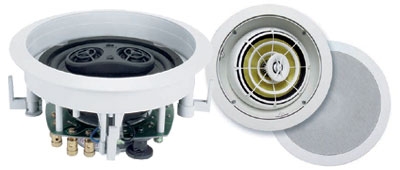The Case of the Invisible Speakers Page 2
Sound ImprovementsDespite these trends, in-wall speakers would still face an uphill battle for acceptance if the sound quality of the speakers hadn't dramatically improved. While a lot of early built-ins looked and sounded suspiciously like repurposed coaxial car speakers, many of today's models use the same high-quality drivers and crossover components found in conventional box speakers. More important, they're designed to deliver high-performance sound from a wall or ceiling.  Atlantic Technology's ICTS 6/3 ceiling speaker (left) has two 3/4-inch tweeters for mono, stereo, or dipole sound, while SpeakerCraft's AIM8 ceiling spearker has pivoting 1-inch tweeter for directing the treble.
Atlantic Technology's ICTS 6/3 ceiling speaker (left) has two 3/4-inch tweeters for mono, stereo, or dipole sound, while SpeakerCraft's AIM8 ceiling spearker has pivoting 1-inch tweeter for directing the treble.
"For a long time, there weren't a lot of speaker companies involved in that business," recalls Scott Ranney, president of Progressive Audio in Columbus, Ohio . "And in all honesty, many installers would go into expensive homes and recommend in-wall speakers that cost a couple of hundred dollars, even though there was a $100,000 area rug on the floor."
Mike Detmer, vice president of Niles, which specializes in custom audio, says that when the in-wall category started to expand a decade ago, many speaker companies viewed the emerging market as a nice incremental business but not a particularly important one. "Speaker manufacturers tended to believe in a specific technology - typically for drivers - and felt that if they stuck that technology everywhere, they'd have great sound. It wasn't that they were bad technologies, but they didn't really understand the marketplace or the application, and they didn't tend to invest in it."
We've also seen an important cultural change, Detmer says: people now want products to adapt to their lifestyles instead of the other way around. "Back then, big, freestanding speakers and amplifiers mounted in racks were the marks of a true aficionado. That doesn't hold true anymore," he says.
These days, speaker manufacturers from Boston Acoustics and Polk Audio to B&W and Thiel offer in-wall and ceiling options, which has helped stamp the category with legitimacy. Even companies like Bose, Atlantic Technologies, and Cambridge SoundWorks, which cut their teeth on systems consisting of tiny satellite speakers with separate subwoofers, are now offering in-wall and ceiling alternatives.
While the emphasis may be on lifestyle, people still expect good sound from reasonably priced products, and meeting that expectation with "invisible" speakers isn't without its challenges. For instance, the sealed enclosures for conventional speakers allow designers to optimize drivers for the cabinet's size and construction. But it's anybody's guess what an installer will find once he opens a wall or ceiling to mount a speaker. Also, conventional speakers are usually positioned at ear level facing the prime seating location, but in-wall speakers seldom are, and ceiling speakers can't be, which makes it challenging to create a convincing stereo or front-stage image.
"Ideally, we'd like everything on the same plane where we're sitting," explains Harvey Electronics' De Stio. "When I install a plasma TV, I usually recommend putting it 4 to 4 1/2 feet up the wall, with the stereo or left/right front speakers flanking it. If the plasma is there, then locating the speakers that low in the wall doesn't look bad."
- Log in or register to post comments


































































